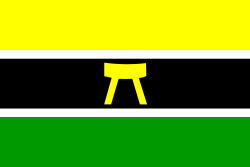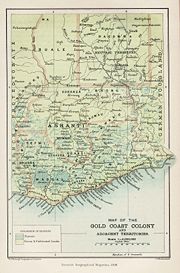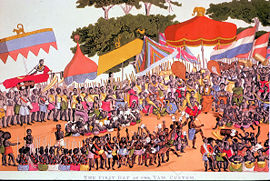Ashanti
Ashanti, or Asante, are a major ethnic group of Ashanti Region in Ghana. The Ashanti speak Twi, an Akan language similar to Fante. For the Ashanti (Asante) Confederacy see Asanteman.
| Ashanti |
|---|
 |
| Total population |
|
Upwards of 10 million |
| Regions with significant populations |
| central Ghana |
| Languages |
| Twi |
| Religion |
| Christianity, Traditional, Islam |
| Related ethnic groups |
| Akan, Fante |
Prior to European colonization, the Ashanti people developed a large and influential empire in West Africa. The Ashanti later developed the powerful Ashanti Confederacy and became the dominant presence in the region.
Contents |
Geography

Ghana has a variable terrain, coasts and mountains, forests and grasslands, lush agricultural areas and near deserts. The Ashanti settled in the central part of present-day Ghana, about three hundred kilometres from the coast. The territory is densely forested, mostly fertile and to some extent mountainous. There are two seasons -- the rainy season (April to November) and the dry season (December to March). The land has several streams; the dry season, however is extremely desiccated. It is hot year round.
Today Ashanti number close to 7 million people (roughly 30% of the Ghanaian population, speaking Asante, also referred to as Twi, a member of the Niger-Congo language group.) Their political power has fluctuated since Ghana's independence, but they remain largely influential. The current president of Ghana, John Agyekum Kufuor is Ashanti. The majority of the Ashanti reside in the Ashanti Region, one of the administrative regions of the country. Kumasi, the capital of the current Ashanti region, has also been the historic capital of the Ashanti Kingdom. Currently, the Ashanti region of Ghana has a population of 3,612,950, making it Ghana's most populous administrative district.[1]
Family
The Ashanti are one of Africa's matrilineal societies where line of descent is traced through the female. Historically, this mother progeny relationship determined land rights, inheritance of property, offices and titles.
The father role was to catalyze the conception and provides the nkra or the soul of the child, that is, the child received its life force, character, and personality traits from the father. Though not considered as important as the mother, the male interaction continues in the place of birth after marriage.
Typically, individual Ashanti did not own land, but rather occupied that which came down from a previous ancestor. Both men and women can possess property made or acquired by individual efforts. Heirlooms and carved stools -- all possessions of family and lineage property -- may be disposed of by individuals if they choose to do so.
Historically, an Ashanti girl was betrothed, if not in childhood, immediately after the puberty ceremony. They did not regard marriage as an important ritual event, but as a state that follows soon and normally after the puberty ritual. The Ashanti required that various goods given by the boy's family to that of the girl, however this was not a 'bride price' situation, but simply stands as an agreement between the two families. A man may marry a cross cousin -- his father's sister's daughter or his mother's brother's daughter. Parallel cousins are members of the same 'abusua (family) and hence prohibited as marriage partners. Sometimes nuptial arrangements were arranged before the birth of the couple. Parents allowed boys some initiative, but he must receive the consent of the households, the only formalities required.
History
Ashanti Kingdom
The Ashanti went from being a tributary state, to a confederation of states, and ultimately a centralized hierarchical kingdom. Beginning as a tributary state of Denkyira, the foremost Akan power during the 16th century, the Ashanti Kingdom or Asante grew out of a confederation of Akan-speaking states led by Osei Tutu, the first Asantehene. Osei Tutu, military leader and head of the Oyoko clan, founded the Ashanti kingdom in the 1670s. [2] He obtained the support of other clan chiefs and using Kumasi as the central base, subdued surrounding Akan states. He challenged and eventually defeated Denkyira in 1701.
Realizing the weakness of a loose confederation of Akan states, Osei Tutu strengthened centralization of the surrounding Akan groups and expanded the powers judiciary system within the centralized government. Thus, this loose confederation of small city-states grew into a kingdom or empire looking to expand its borders. Newly conquered areas had the option of joining the empire or becoming tributary states.[3] Opoku Ware I, Osei Tutu's successor, extended the borders, embracing much of present day Ghana's territory. [4]
The Golden Stool
Essential to Ashanti nationhood is the legend of the 'Golden Stool' (sika 'dwa), the legend actually tells of the birth of the Ashanti kingdom itself. In the seventeenth century, in order for the Ashanti to win their independence from Denkyira, then another powerful Akan state, a meeting of all the clan heads of each of the Ashanti settlements was called. In this meeting, the Golden Stool was commanded down from the heavens by Okomfo Anokye, the Priest, or sage advisor, to the very first Asantehene (Ashanti king), Osei Tutu I. The Golden Stool floated down from the heavens straight into the lap of Osei Tutu I. Okomfo Anokye declared the stool to be the symbol of the new Ashanti union ('Asanteman'), and allegiance was sworn to the Golden Stool and to Osei Tutu as the Asantehene. The newly founded Ashanti union went to war with Denkyira and defeated it. [5]
The Golden Stool is sacred to the Ashanti, as it is believed that it contains the 'Sunsum' — spirit or soul of the Ashanti people. Just as man cannot live without a soul, so the Ashanti would cease to exist if the Golden Stool were to be taken from them. The Golden Stool is not just sacred; it is a symbol of nationhood, a symbol that binds or unifies all Ashanti.
The Golden Stool is a curved seat 46 cm high with a platform 61 cm wide and 30 cm deep. Its entire surface is inlaid with gold, and hung with bells to warn the king of impending danger. It has not been seen by many and only the king and trusted advisers know the hiding place. Replicas of the stool have been produced for the chiefs and at their funerals are ceremonially blackened with animal blood, a symbol of their power for generations.
The Ashanti have always defended their Golden Stool when it was at risk. In 1896, the Ashanti allowed their King, Prempeh I, to be exiled rather than risk losing a war and the Golden Stool in the process. The Governor of the Gold Coast, Sir Frederick Hodgson, demanded to sit on the stool in 1900. The Ashanti remained silent and when the assembly ended, they went home and prepared for war. Although they lost on the battle field, they claimed victory because they fought only to preserve the sanctity of the Golden Stool, and they had. Then in 1920, a group of African road builders accidentally found the Golden Stool and stripped it of its gold ornaments. They were tried by an Ashanti court, found guilty, and the death penalty was imposed. But the British intervened and the sentence was commuted to perpetual banishment.
The Ashanti have always been proud of the uniqueness of their Golden Stool, and it was a symbol of not only their independence, but a common bond between their people. When the King of Gyaman, Adinkra, made a Golden Stool for himself, the Asantehene was so annoyed that he led a massive army against him. Adinkra was completely destroyed near Bondoukou, and he was decapitated. The Asantehene then proceeded to order the melt down of Adinkra's golden stool, and for it to be made into two masks, to represent his "ugly" face. These masks remain hanging on each side of the Ashanti Golden Stool to this day.
European colonization

The Ashanti strongly resisted attempts by Europeans, mainly the British, to subjugate them. The Ashanti aligned themselves with the Dutch to limit British influence in the region. Britain annexed neighbouring areas.
Ashanti was one of the few African states able to offer serious resistance to European colonizers. Between 1823 and 1896, Britain fought four wars against the Ashanti kings (the Anglo-Ashanti Wars). In 1900, the British finally defeated the kingdom and incorporated it into the Gold Coast colony.
Because of the long history of mutual interaction between Ashanti and European powers, the Ashanti have the greatest amount of historiography in sub-Saharan Africa. The British touted the Ashanti as one of the more civilized African peoples, cataloguing their religious, familial, and legal systems in works like R.S. Rattray's Ashanti Law and Constitution
Independence
Relations improved, however, and in 1926 the Asantehene was given ceremonial control over Kumasi. In 1935 the full role of leader of the Ashanti people was restored.
Modern Ashantis
In modern Ghana, there is no ethnic group or tribe which comprise a majority of the population. While the entire Akan population make a plurality 49% of the population, Ashanti, Fante and other Akans make up that percentage. However, it is estimated that Ashanti are 14% of Ghana's population, followed by Fante, the Ewe and Ga. This along with their history makes them very influential both politically and economically. The current president John Kufuor is an Ashanti and was elected in part with their support.
Ashanti are largely Protestant and Catholics Christian; the major denominations represented are Methodist and Anglican, although Pentecostalism is growing in popularity.
While tribal and ethnic identity are important for Ashanti and other Ghanaians, they do not define a person nor carry as much weight as they did hundreds of years ago. Being an Ashanti now is mostly a point of reference and a linguistic tie more than a strongly cohesive tribe. In other words, typically Ashanti and Ghanaians in general do not place extreme emphasis on tribe and are more nationalistic.
See also
- History of Ghana
- Asanteman
- Fante Confederacy
- Rulers of the Akan state of Asante
- War of the Golden Stool
Literature
- Robert B. Edgerton, 1995, The Fall of the Asante Empire. The Hundred-Year War for Africa's Gold Coast. New York, ISBN 0-02-908926-3
- N. Kyeremateng, K. Nkansa, 1996, The Akans of Ghana: their history & culture, Accra, Sebewie Publishers
- Alan Lloyd, 1964, The Drums of Kumasi, Panther, London
- Ernest E. Obeng, 1986, Ancient Ashanti Chieftaincy, Ghana Publishing Corporation, ISBN 9964-1-0329-8
- Quarcoo, Alfred Kofi, 1972, 1994 The Language of Adinkra Symbols Legon, Ghana: Sebewie Ventures (Publications) PO Box 222, Legon. ISBN 9988-7533-0-6
- Kevin Shillington, 1995 (1989), History of Africa, St. Martin's Press, New York
- D. Warren, The Akan of Ghana
References
- ↑ Ashanti.com.au - Ashanti
- ↑ Kevin Shillington, History of Africa, St.Martin's, New York, 1996 (1989), p. 194
- ↑ Giblert, Erik Africa in World History: From Prehistory to the Present 2004
- ↑ Shillington, loc. cit.
- ↑ Alan Lloyd, The Drums of Kumasi, Panther, London, 1964, pp. 21-24
http://www.archimedes.free-online.co.uk/ghana.htm
External links
- Ashanti People hand History Profiles history and other aspects of the Ashanti.
- Ashanti Page at the hhEthngraphic Atlas, maintained at Centre for Social Anthropology and Computing, University of Kent, Canterbury
- Ashanti Kingdom at thhhe Wonders of the African World, at PBS
- Ashanti Culture contains a selectedh list of Internet sources on the topic, especially sites that serve as comprehensive lists or gateways
- Africa Guide contains information about the culture of the Ashanti
- [1]